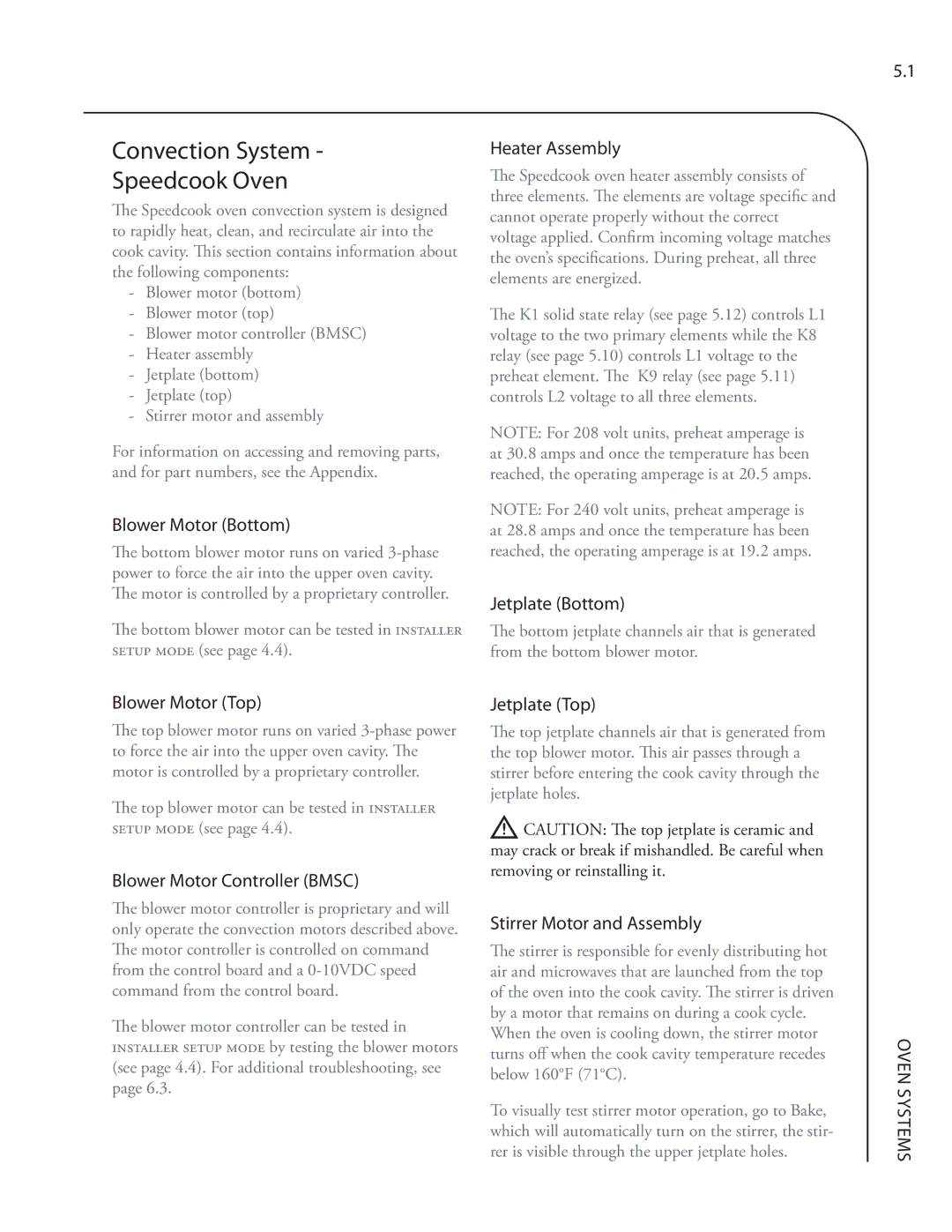
Convection System -
Speedcook Oven
The Speedcook oven convection system is designed to rapidly heat, clean, and recirculate air into the cook cavity. This section contains information about the following components:
-Blower motor (bottom)
-Blower motor (top)
-Blower motor controller (BMSC)
-Heater assembly
-Jetplate (bottom)
-Jetplate (top)
-Stirrer motor and assembly
For information on accessing and removing parts, and for part numbers, see the Appendix.
Blower Motor (Bottom)
The bottom blower motor runs on varied
The bottom blower motor can be tested in installer setup mode (see page 4.4).
Heater Assembly
The Speedcook oven heater assembly consists of three elements. The elements are voltage specific and cannot operate properly without the correct voltage applied. Confirm incoming voltage matches the oven’s specifications. During preheat, all three elements are energized.
The K1 solid state relay (see page 5.12) controls L1 voltage to the two primary elements while the K8 relay (see page 5.10) controls L1 voltage to the preheat element. The K9 relay (see page 5.11) controls L2 voltage to all three elements.
NOTE: For 208 volt units, preheat amperage is at 30.8 amps and once the temperature has been reached, the operating amperage is at 20.5 amps.
NOTE: For 240 volt units, preheat amperage is at 28.8 amps and once the temperature has been reached, the operating amperage is at 19.2 amps.
Jetplate (Bottom)
The bottom jetplate channels air that is generated from the bottom blower motor.
5.1
Blower Motor (Top)
The top blower motor runs on varied
The top blower motor can be tested in installer setup mode (see page 4.4).
Blower Motor Controller (BMSC)
The blower motor controller is proprietary and will only operate the convection motors described above. The motor controller is controlled on command from the control board and a
The blower motor controller can be tested in installer setup mode by testing the blower motors (see page 4.4). For additional troubleshooting, see page 6.3.
Jetplate (Top)
The top jetplate channels air that is generated from the top blower motor. This air passes through a stirrer before entering the cook cavity through the jetplate holes.
![]() CAUTION: The top jetplate is ceramic and may crack or break if mishandled. Be careful when removing or reinstalling it.
CAUTION: The top jetplate is ceramic and may crack or break if mishandled. Be careful when removing or reinstalling it.
Stirrer Motor and Assembly
The stirrer is responsible for evenly distributing hot air and microwaves that are launched from the top of the oven into the cook cavity. The stirrer is driven by a motor that remains on during a cook cycle. When the oven is cooling down, the stirrer motor turns off when the cook cavity temperature recedes below 160°F (71°C).
To visually test stirrer motor operation, go to Bake, which will automatically turn on the stirrer, the stir- rer is visible through the upper jetplate holes.
OVEN SYSTEMS
